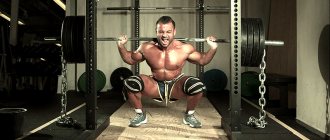Hello, hello, dear blog readers and bodybuilding enthusiasts! I’m with you again – Vitaly Okhrimenko, and today we’ll talk about such a thing as periodization in bodybuilding.
Instead of an introduction, I should note that periodization is not suitable for green athletes; it is intended for experienced bodybuilders who have experienced muscle stagnation, or for those guys who have noted a decrease in progression for unknown reasons. It is especially important to pay attention to the principle of periodization for those bodybuilders who can barely drag their legs into the gym from workout to workout, constantly carry huge weights and begin to think about whether to quit this grueling sport, from which you are tired as hell, and little progress is noticeable. The paradox is that the more results you achieve, the larger your muscles are today, the more difficult it is for you to add muscle mass and strength, working according to the usual linear training scheme (split training).
You can train hard and for a long time, quickly achieve enviable results, but sooner or later you will notice (and if you are reading this article, you may have already noticed) that progress is either minimal or non-existent.
Previously, it was so pearly, it only managed to tear T-shirts on the back, but now what happened? Is this really the end? Is it really possible to develop further only with the help of chemistry? No friend, you will continue to grow, you will continue to progress, and I will teach you how to do it! Before you start studying periodization, it wouldn’t hurt to read the article on how to swing correctly? You can find a lot of interesting and useful things in it. I also highly recommend studying works on stretching; it often happens that in order to overcome stagnation, all athletes need to do is just start doing stretching exercises.
You got to the big weights with a lot of hard work, but what next? And then your body begins to go nuts from the critical loads at each workout, and a point comes where not so much the muscles, but the nervous system, are no longer able to handle the systematic stress load placed on the body. This is where this wonderful invention of mankind – periodization – will come to your aid. So, let’s say you spent many months, maybe even years, training exclusively with heavy weights, 4-8 repetitions in one approach, and the results from such training decreased over time. And the body is already too overworked to continue exercising at such an aggressive pace. This is where you need to change the rules of the game, you need to increase muscle stimulation, change the usual loads to which the muscles have already managed to adapt, to unusual ones that can stimulate new muscle fibers to grow.
What is muscle hypertrophy and what does it depend on?
If you want to build muscle, then you need to stick to a clear plan. To make this task easier, you should establish a specific daily routine for yourself, including exercise, nutrition, rest and sleep. Unfortunately, choosing a few exercises and diets and sticking with them is not enough. Many people start doing the same exercises for the same muscle groups while sticking to the same diet - but this does not help them achieve their goal, because they have not understood the importance of a systematic approach to bodybuilding. And they stuck to the same training system for months or years, without creating the necessary level of stress for the muscles, or, on the contrary, they changed the scheme very often, which also did not give results.
If you enter the gym, look for already familiar exercise equipment with your eyes and start doing strength training according to the same plan, then even after six months of training you may not make progress.
To achieve muscle hypertrophy, you need to consider a long-term training plan that will regularly create the necessary level of stress to stimulate muscle growth. It is important to gradually change your plan, introduce periodization with a smooth transition to new exercises and load volumes. One of the best ways is considered to be linear cycling (periodization) of loads in bodybuilding.
Planning a training cycle
Before you use block periodization, you should determine how many weeks before the competition you have. Sometimes it’s even more convenient to count backwards from the day of the competition itself. This allows the lifter to determine how much time to spend on each block, when to add equipment work, when to do fast weeks, and how they can make adjustments if needed. Below is an 18 week training cycle. The blocks are divided by week and equipment used. I repeat, everything listed below serves only as an example, and is determined strictly individually, depending on the athlete’s experience, level of equipment proficiency, etc. The countdown is from the day of the competition in the opposite direction.
Week 1: Competition Week Week 2: Recovery Loading Week 3: Conversion Block (Full Outfit) Week 4: Implementation Block (Full Outfit) Week 5: Recovery Outloading Week 6: Conversion Block (Tank Top, Briefs, Jumpsuit or Both , at the discretion of the lifter) Week 7: Conversion block (t-shirt, briefs, suit or both, at the discretion of the lifter) Week 8: Recovery Week 9: Accumulation block (without equipment) Week 10: Accumulation block (without equipment) Week 11: Accumulation block (unequipped) Week 12: Recovery unloading Week 13: Conversion block (Unequipped or partially equipped) Week 14: Conversion block (Unequipped or partially equipped) Week 15: Recovery unloading Week 16: Storage block (without equipment) Week 17: Storage block (without equipment) Week 18: Storage block (without equipment)
What is linear periodization?
Linear periodization of loads is a system for organizing the training process, which implies a gradual and one-sided progress of the parameter developed by the bodybuilder, the volume and intensity of training.
Periodization is any periodic change in your training plan. Periodization is used in bodybuilding, powerlifting and weightlifting. A signal to include periodization in the training process can be stagnation in the weights, which, sooner or later, occurs in all athletes who continuously train in failure.
Essentially, linear periodization involves constantly moving from high-volume, low-intensity exercise to low-volume, higher-intensity exercise. Fortunately, words like high volume or high intensity only sound scary, but in reality the plan is quite simple, and some may find it quite monotonous. But it has the consistency you need and is varied enough to stimulate muscle growth.
Realization mesocycle
The implementation block is the final stage of pre-competition preparation. Volume is low, intensity is high. Because of this, some call it a “spire.” In this mesocycle, training is focused on competitive movements. In general - special exercises are practically excluded, and general exercises, if used, are used exclusively for the purpose of preventing injury, or for blood circulation.
The load is used from 90%. Exercises must be performed in accordance with the rules of your federation. Enough time should be allowed between workouts for complete recovery. The frequency of training has also been reduced. The block usually lasts about two weeks; Upon completion, time should be allocated for recovery and unloading (1 - 2 weeks) in accordance with individual needs.
Before you start: Track your progress
This is a necessary part of training: you need to know how much weight you can lift in order for the training system to work most effectively. The proven method of gradually increasing the load may seem boring to some, but the most important thing is that it works.
Important: Not only beginners and people with an average level of bodybuilding can use this plan. Individuals of any fitness level can begin training using a linear periodization system to maximize their muscle hypertrophy, regardless of their experience in the gym.
Many athletes, such as Ed Cohn, Lamar Gantt and Fred Hatfield, also used linear periodization to build muscle, and their mass training programs were similar in the sequence of exercises and, more importantly, in the gradual increase in load.
These athletes trained for 12-16 weeks, adding a little weight to the bar each week until they reached their personal working maximum. By tracking their strength progress, measuring muscle size, and adjusting their nutrition, they were able to achieve their goal.
Cumulative mesocycle
The cumulative mesocycle can be compared to building the foundation for a house. The intensity is low, but the volume is high. Training includes mostly general and general - special exercises. Not many special moves are used. In powerlifting, the goal of this block is to hypertrophy and improve overall performance. The percentages are selected individually, but usually range from 50 to 70%. When calculating the volume, I relied on Prilepin's table. The duration of the block can vary from 2 to 6 weeks. Once again, a lot depends on the individual lifter and training level. The lower the level, the longer the mesocycle. The block length may also vary depending on the annual plan. The deload phase of recovery after this block is optional, but may be included depending on the lifter.
Basics of linear periodization
There are many muscle hypertrophy programs that use linear periodization. Usually, what they all have in common is that the basis of the program is the same. It often happens that the only thing that differs between these programs is the rep range.
The linear cycle in bodybuilding is usually divided into four phases:
- In the first phase, loads are used that are 15-25% less than the peak load of the previous cycle, gradually increasing to 90-95% of the level of the previous cycle. This phase usually lasts 2-4 weeks. Most often this is a large volume of low-intensity training (high-repetition training with light weight). At the same time, it is important not to exceed the loads planned by the program, even if the bodybuilder’s capabilities are not used to their full potential - in this case, the gradual increase in load will disappear, which will entail a violation of the principles of periodization.
- The second phase also usually lasts 2-4 weeks. During this period, the total load continues to increase while training volumes decrease - usually this means increasing weights and decreasing the number of approaches.
- The third phase lasts 2-3 weeks and involves reaching the maximum of the previous cycle. Typically, during this period, the volume of training is reduced due to the number of approaches and the number of repetitions, and the weights lifted significantly increase. During this and the next period, rest between approaches and during free time from training is very important. Only after fully restoring your strength can you work at full strength; any fatigue sharply reduces the effectiveness and quality of the training.
- The last phase is the peak phase, in which the athlete exceeds his maximum and sets a new bar, which will become the starting point for the next cycle. At the same time, the longer this phase, the better - you should not work to failure in the first workout and immediately reach the maximum, this will not give the desired result.
After reaching the maximum possible load, there is a short recovery cycle before the next cycle.
Changing training volume is achieved in three ways: progression in repetitions (adding the number of repetitions in each approach), progression in approaches (increasing the total number of approaches in a given exercise), progression in training frequency (increasing the number of workouts in one weekly microcycle).
Changing the intensity of training is achieved, as a rule, by progression in the weight of the weights (increasing the weight of the equipment in each workout), but in addition to this, progression in rest (decreasing the time intervals between approaches) and progression in speed (decreasing the time it takes to complete the approach) are sometimes used.
More or less: You should change rep ranges when you reach a certain percentage of your maximum weight. Then, try to repeat this exercise as many times as possible. Eg:
If you started the exercise by lifting approximately 60% of your weight, then you should do the next sets by reducing the weight lifted by 10%. Try to do at least as many repetitions as before.
In the next approach - the third - the rules are the same. Following the previous examples, try to perform the same number of repetitions as before. If you can repeat this more times, it will be even better.
Transformative mesocycle
It is during this mesocycle that many athletes have questions about planning. To fill this gap, I have added several working diagrams to the article.
The percentages set out below should be treated as a guide. Minor adjustments are acceptable. The only thing that can cause confusion on the scale is equipment. It is very important to take your actual training maximum as a basis. When performing certain movements, you should take into account the technique, and base the seto - repeated y pattern - on this. Also, count the percentages of the maximum in a special exercise, do not even think about taking them from a competitive exercise, for example, a squat. Otherwise, don't be surprised why you were suddenly crushed by a barbell.
First example: Transformational mesocycle (4 training days per week)
Day 1: Press
Press in a T-shirt 75 - 90% 4 - 12 repetitions total
Board press (with or without a shirt) 75 - 85% or based on Subjective Load Rating (SRR) 6 - 15 reps total
Horizontal rows 30 - 40 repetitions total
Stretching a rubber band in front of you with straight bent arms 30 - 40 repetitions in total
Day 2: Cravings
Competition Rows 75 - 90% 4 - 12 reps total
Squat with safety squat bar on a low box 75 - 85% or based on ROP 6 - 15 reps total
Romanian deadlift with snatch grip 3 - 4 sets 6 - 10 reps *based on RPT
Abs, upper back, hamstrings 2 - 3 sets for each muscle group 12 - 20 repetitions
Day 3: Bench
Press in a T-shirt 75 - 90% 4 - 12 repetitions total
Close-grip incline press 3 - 5 sets 6 - 10 reps *based on ROP
Vertical row 30 - 40 repetitions total
Raises arms in front of you 30 - 40 repetitions total
Day 4: Squat
Squat in briefs or a suit without straps, or both 75 - 90% 4 - 12 repetitions total
Rows in the rack (= from the plinths) 75 - 85% or based on RNC 6 - 15 repetitions total
Narrow stance TA style squat 3 - 4 sets 6 - 10 reps *based on ROP
Abs, upper back, lower back 2 - 3 sets for each muscle group 12 - 20 repetitions
This is the basic split for the transformative mesocycle. Everything given above is suggested for athletes performing in equipment. If you compete in the raw division, everything remains the same, just done without equipment. Percentages and sets - repeated patterns remain unchanged.
Training becomes more narrowly focused, because either competitive movements or their variants are taken. On bench press days, horizontal and vertical rows are present, only in a reduced volume, compared to the accumulation block. On squat days, the primary movement is the competition squat, followed by a deadlift specific (SP) exercise, and then a general squat specific (OC) exercise at a lower intensity. On deadlift day, everything is the same, only in reverse - deadlift - SP - squat - OC - deadlift. On these two days, general exercises should be done in a “circular” style to maintain the level of general physical fitness. If necessary, this part is removed, depending on how you feel. The intensity of circular work is low.
This scheme has its pros and cons. Pros: such a volume of special and general special work will better “translate” into results in competitive movements. Cons: training in this style takes a lot of time. Using basic, multi-joint exercises, you have to pay more attention to technique, and, as a result, take longer rest breaks between sets. In addition, a 4-day split is not suitable for everyone, due to the work week schedule. For some, time for recovery will not be enough. Others may need more general exercises to target a specific area due to an old injury, weak spot, etc. P.
Here is another example of a 4 day split
The press days remain the same, but there are slight changes made to the squat and deadlift days.
Day 1: Press
Press in a T-shirt 75 - 90% 4 - 12 repetitions total
Board press (with or without a shirt) 75 - 85% or based on Subjective Load Rating (SRR) 6 - 15 reps total
Horizontal rows 30 - 40 repetitions total
Stretching a rubber band in front of you with straight bent arms 30 - 40 repetitions in total
Day 2: Cravings
Competition Rows 75 - 90% 4 - 12 reps total
Squat with safety squat bar on a low box 75 - 85% or based on ROP 6 - 15 reps total
GHR (with weights or resistance bands) 32 – 50 reps total
Upper back - optional
Press
Day 3: Bench
Press in a T-shirt 75 - 90% 4 - 12 repetitions total
Close-grip incline press 3 - 5 sets 6 - 10 reps *based on ROP
Vertical row 30 - 40 repetitions total
Raises arms in front of you 30 - 40 repetitions total
Day 4: Squat
Squat in briefs or overalls without straps, or both 75 - 90% 4 - 12 repetitions total
Rows in the rack (= from the plinths) 75 - 85% or based on RNC 6 - 15 repetitions total
Reverse hyperextensions 3 - 5 sets 8 - 12 reps
Press
As you may have noticed, in this version of the split there are fewer general and special exercises. Training will not be as time-consuming, and those who find it difficult to remove such a variable as “real life” from the equation will find it a little easier to recover. In addition, it is permissible to add general exercises to work on weak points.
Some of you may have various other obligations in addition to work. Since the option of dismissal and divorce does not suit you, you can try the scheme given below. The scheme will work if higher powers (family, work, etc.) allow you to train 3 days a week, without limiting your time. This option is also suitable for those who are recovering well and want to add special and general exercises. A bonus to this scheme is the opportunity to work on the big three special and general special exercises.
Third example: Transformative mesocycle (3 training days per week)
Day 1: Press - Deadlift - Squat
Press in a T-shirt 75 - 90% 4 - 12 repetitions total
Thrusts in the frame (= from plinths) 75 - 85% or based on RNC 6 - 15 repetitions in total
Narrow stance TA style squat 3 - 4 sets 6 - 10 reps *based on ROP
A few sets of lats, abs, or whatever you have time for.
Day 2: Deadlift - Squat - Press
Competition Rack Row 75 – 90% 4 – 12 reps total
Squat with safety squat bar on a low box 75 - 85% or based on ROP 6 - 15 reps total
Close-grip incline press 3 - 5 sets 6 - 10 reps *based on ROP
A few sets of hamstrings, abs, or whatever you have time for.
Day 3: Squat - Press - Deadlift
Squat in briefs or overalls without straps, or both 75 - 90% 4 - 12 repetitions total
Board press (with or without a shirt) 75 - 85 or based on ROP 6 - 15 reps total
Romanian deadlift with snatch grip 3 - 4 sets 6 - 10 reps *based on RPT
A few sets on the lower back, abs, or whatever you have time for.
If you only have the opportunity to train 3 days a week for a limited time, the scheme outlined below will be the optimal solution. It will not contain so many general and special exercises, but the basics will be the same as in the diagram above.
Fourth example: Transformative mesocycle (3 training days per week)
Day 1: Press - Deadlift
Press in a T-shirt 75 - 90% 4 - 12 repetitions total
Thrusts in the frame (= from plinths) 75 - 85% or based on RNC 6 - 15 repetitions in total
Horizontal row 3 sets 10 - 15 reps
Reverse hyperextensions 3 sets 10 - 15 reps
Day 2: Deadlift - Squat
Competition Rack Row 75 – 90% 4 – 12 reps total
Squat with safety squat bar on a low box 75 - 85% or based on ROP 6 - 15 reps total
GHR 30 – 50 reps total
Press
Day 3: Squat - Press
Squat in briefs or overalls without straps, or both 75 - 90% 4 - 12 repetitions total
Board press (with or without a shirt) 75 - 85% or based on Subjective Load Rating (SRR) 6 - 15 reps total
Goodmoning with rubber bands 40 - 60 repetitions total
Dumbbell press 30 - 50 repetitions total
And finally, another version of the program for the transformative mesocycle. I know that many lifters like to use resistance adjustments in their training, especially those who compete in multi-layer equipment.
I will outline my position on adjusting resistance: I do not consider it necessary to use it in special exercises, since one of the goals of such exercises is to improve technique. Rubber bands change the dynamics of movement. True, the same cannot be said about chains. Of course, they can be used in special exercises, but, in most cases, it is better to leave them for general special exercises.
Below is an example of using bands and chains in general specific exercises within a 4-day split. The reason I use SRR (Subjective Rating of Load) is because it's pretty hard to give a person percentages when you don't know how exhausting the main exercise is for them. And with the use of drag adjustment, it becomes even more difficult to tell.
Day 1: Press
Press in a T-shirt 75 - 90% 4 - 12 repetitions total
Board Press with Resistance Bands Based on Subjective Load Rating (SRR) 6 – 15 reps total
Horizontal rows 30 - 40 repetitions total
Stretching a rubber band in front of you with straight bent arms 30 - 40 repetitions in total
Day 2: Cravings
Competition Rows 75 - 90% 4 - 12 reps total
Box Squat with Bands and Chains Based on RRP 6 – 15 reps total
GHR (with weights or resistance bands) 32 – 50 reps total
Upper back - optional
Press
Day 3: Bench
Press in a T-shirt 75 - 90% 4 - 12 repetitions total
Close-grip incline press 3 - 5 sets 6 - 10 reps *based on ROP
Vertical row 30 - 40 repetitions total
Raises arms in front of you 30 - 40 repetitions total
Day 4: Squat
Squat in briefs or overalls without straps, or both 75 - 90% 4 - 12 repetitions total
Rows in the frame (= from the plinths) with rubber bands Based on the RNC 6 - 15 repetitions in total
Reverse hyperextensions 3 - 5 sets 8 - 12 reps
Press
Why Linear Periodization Works
This type of program is commonly called a drop set program because it focuses on dropping weight for each repetition of a set of exercises.
Drop sets (from the English drop - reset, sets - sets) are sets with weight loss. You start a set with a certain weight of weight - be it free weight or weights in a machine, bring the set to the point where it is no longer possible to perform the movement with strict technique, reduce the weight of the weight by an average of 25% and again, do the set until refusal. The classic version of the drop set implies a minimum gap between mini-sets; ideally, pauses are minimal, the weight changes in 2-3 seconds. However, in practice, the time spent on weight loss may take longer, and this is not a significant problem - such options, where the interval reaches 15-20 seconds, are also quite acceptable and effective. This is a “classic” drop set.
Highlight:
- Triple drop sets,
- Quadruple drop sets
- Progressive drop sets
- Reverse drop sets
- Drop supersets
In fact, many beginners start doing the opposite of drop sets.
Instead of decreasing the weight lifted and increasing the number of repetitions, they instead increase the weight each set and decrease the number of repetitions.
This type of exercise for beginners, in which more and more weight is added each time, is called the pyramid method. The “base” of the pyramid is low-weight, high-rep sets, and the “peak” is high-weight, low-rep sets.
Linear periodization is often called the inverse pyramid method. This is the opposite of the regular pyramid technique, and here the first stage of training involves heavy weight and low repetitions.
By the end of the workout, you'll have completed more reps with lighter weights on the barbell. While the main goal of linear periodization is to target the same rep range, sometimes you see exercises that end in a sort of “super series”—a final exercise that involves lifting as much weight as possible as many times as possible before complete muscle failure.
So why is linear periodization so much more effective than the pyramid system? Actually, the answer is quite simple. With linear periodization you will be able to lift more weight much faster than with a pyramid.
If you lift a heavy weight for five reps and then lower the weight for subsequent sets, you can push yourself to the max.
With this program, your total volume of weight lifted will be much higher than if you were training using the pyramid method.
Weekly progress
At the beginner level, this type of strategy will get you to - at a minimum - 15 to 40 repetitions of each exercise every week.
This amount will not only increase your muscles, but will also make them stronger, which is why linear periodization is considered one of the most successful programs. The next important stage of this program is linear progression. Linear progression is a mandatory increase in weight on the bar every week. For example, in the second week of training, try adding an extra 2 kilograms per set for exercises on small muscle groups, such as biceps, triceps or shoulders. If you want to train large muscle groups, such as the chest, back or legs, then add 5 kilograms.
Over time, you may no longer be able to do the exercises as many times as easily as you did at the beginning of your training, as your weight increases. Still try to maintain the same number of repetitions.
It will definitely be much more difficult to do, but this is what will lead you to the result. Fight for your improvement. If you still can't catch up to your rep level, consider slowing down your training program. For example, reduce additional kilograms from 5 to 2.
Go to advanced level
Like most programs, linear periodization will eventually lead you to a certain plateau. This is completely normal, as after some time you should choose a new strategy to surprise your muscles in a different way and stimulate their growth.
Once your body gets used to these types of exercises, you can return to compound exercises to warm up your muscles and increase strength and size.
“Advanced” exercises may sound scary, but they really aren't. These are just slightly different variations of the previous exercises.
Here are some examples:
- Instead of bench pressing with a regular or wide grip, try doing it with a close grip.
- Instead of doing classic squats, try doing front squats.
You will be very surprised when you see the effect small changes in exercise have. Remember: The purpose of advanced exercises is to prevent your muscles from becoming accustomed to one set of workouts.
Your muscles love to maintain balance and stability, so it will take a lot of hard work and sweat to make them bigger. Once you let them get used to the type of exercise, it will stop affecting them.
So you shouldn't even give them a chance. You must use different types of training, increase the load and simply “force” the muscles to become stronger and bigger.
conclusions
Block periodization cannot be called a universal method. And it's not even about sets - repeated schemes, specific exercises or personal preferences. Block periodization is an organization scheme that classifies training from general to special. To successfully use this system, the lifter must be able to thoughtfully incorporate specific exercises into blocks that follow the principles of general, general-specific, and specific training.
Once a lifter understands this planning format, he will be able to successfully use the qualities developed in the early stages to improve his performance in the competitive squat, press, and deadlift. I hope this article got you thinking and cleared up any misunderstandings about block periodization.
With us you can.
A Practical Guide to Using Block Periodization in Powerlifting. Author: Gabrielle Naspinski.











